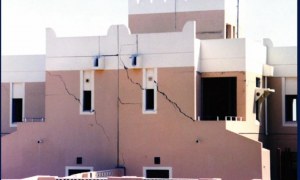🕑 Reading time: 1 minute
Diaphragm wall is a continuous reinforced concrete wall constructed in the ground to support major construction activities like the construction of dams, tunnel approaches, deep basements and enclosures. They act as a retaining wall, support for the underground structure, as a foundation or facilitate cut off provision in order to support deep excavation.
The construction sequence and the varied features of a
Contents:
Features of Diaphragm Wall
A diaphragm wall forms a rectangular section constructed in-situ under the soil. Hence, this is an underground concrete wall. These walls are constructed panel-by-panel each interlocked to ensure structural stability and water tightness.
The diaphragm walls can have a thickness ranging from 60cm to 150cm with a width of 2.0 to 3.5m. The diaphragm walls can be constructed up to a depth of 60m.
How to construct a Diaphragm Wall?
The construction sequence mainly has three steps:
- Construction of Guide Wall
- Excavation of the panel
- Wall Concreting

Image Courtesy: www.railsystem.net
1. Construction of Guide Wall
Guide walls are two temporary parallel beams constructed along the side of the wall in order to guide the excavation tool and stabilise the top portion. The implementation of guide walls prior to diaphragm-wall construction helps to maintain the horizontal alignment and continuity of the diaphragm walls constructed. Guide walls also:
- Avoid Soil collapse
- Help mark the panel positions
- Support the reinforcement steel cages

As the slurry levels of soil vary largely, it is necessary to have
2. Excavation of Panel
This stage includes soil-removal and stabilisation. A rectangular excavation tool is used to excavate the panel section. A clamshell or grab is used to excavate the trench in normal soil. Grab suspended by a crane or cable easily moves into the soil. If any obstruction is encountered, it is broken by the means of a gravity hammer and taken out by means of the grab.
The above procedure must be conducted with adequate excavation support, otherwise, the sides of the excavated trench can collapse. To protect the sides, bentonite slurry is used. The slurry helps in producing lateral pressure that is sufficient to retain the vertical soil.
3. Wall Concreting
This stage involves the concreting of the panel excavated. Initially, the reinforcement cage is inserted into the trench. If the depth of the
Once the reinforcement is placed, the concrete is poured into the trench with the help of tremie pipes. The use of tremie pipes helps to avoid segregation of concrete. The poured concrete replaces the bentonite clay in the trench. The density of bentonite is low compared to concrete hence is replaced during the concreting. The bentonite clay displaced is collected and reused.
Read More: Earth Retaining Systems in Deep Excavation
Diaphragm Wall Connections
Mainly two types of joint design are employed in diaphragm walls. They are by using:
- Stop End Pipes
- Disposable Pipes
1. Stop End Pipes
In this method, two steel pipes are inserted into the trench before concreting, so that after concreting a semi-circular end section panel is obtained. The panel formed with concave ends forms the primary panel. Alternatively, an intermediate section is formed where the

2. Disposable PVC Pipes
In this method, two pipes are arranged at the ends of the steel reinforcement cage of the panel. The concreting is performed for the primary panel leaving the pipes with slurry. During the concreting of the secondary panel using a dedicated tool, the separation is broken as shown in figure -4 below.

Fig.4. Diaphragm Joints by Disposable PVC Pipes; Image Courtesy: http://soilmec.com.au


